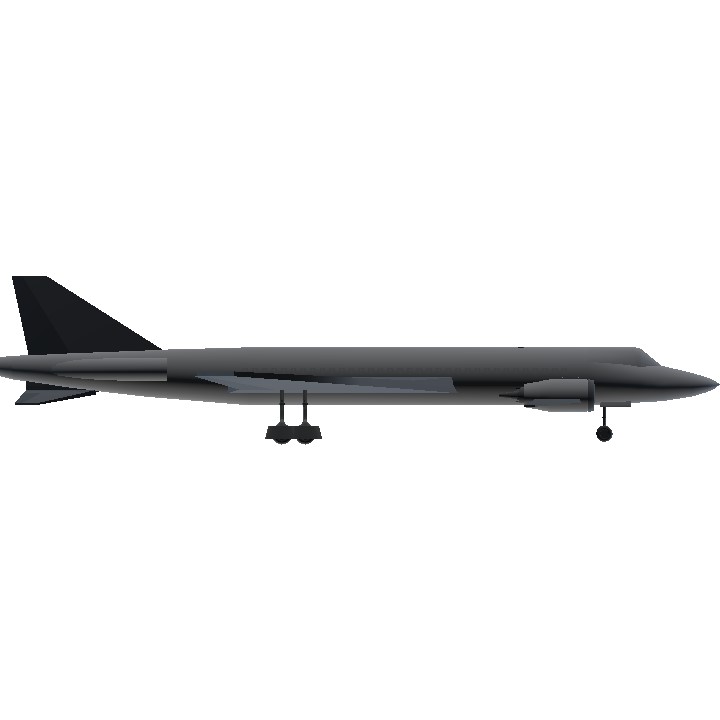Concept and Origins
The Aeolus SL-300, a supersonic civilian jetliner, emerged during a time when aviation innovators were looking to push the boundaries of air travel. Designed by the Skylift Aerospace Corporation, the SL-300 was conceived as a luxury supersonic passenger jet for wealthy business executives, high-profile politicians, and those seeking rapid transcontinental travel. The jet was inspired by military technology but adapted for civilian use, a bold move that immediately set it apart from competitors like the Concorde's successors.
The SL-300's most striking features were its canards, large swept wings, and its unusual three-engine configuration:
- Two tilt-capable engines mounted next to the cockpit gave it unprecedented agility for a civilian aircraft, enabling unique flight paths and emergency evasive maneuvers.
- A powerful engine in the tail fuselage provided the thrust required for supersonic speeds, making it one of the fastest commercial airliners ever built.
The airframe’s instability more akin to a fighter jet than a passenger plane lt was a deliberate design choice. By incorporating technology from advanced fighter jets, including fly-by-wire controls, engineers enabled the SL-300 to achieve Post-Stall Maneuvering (PSM), a feature previously unheard of in civilian aviation. This allowed the aircraft to perform dramatic maneuvers like controlled flat spins or high-angle turns, though these capabilities were reserved strictly for testing and emergencies.
Capabilities and Use
The SL-300 was capable of reaching Mach 1.0, effectively halving the travel time on intercontinental routes. Its unique PSM capability meant that it could recover from aerodynamic stalls or turbulence with ease, giving it a safety edge in extreme situations. The two engines near the cockpit could tilt 25° up and down, providing not only improved maneuverability but also allowing shorter takeoffs and landings compared to other supersonic aircraft.
The Aeolus SL-300 could seat 60-80 passengers in an ultra-luxury configuration, offering a spacious cabin with premium features. This small capacity, combined with high operating costs, relegated the SL-300 to niche markets, such as high-profile charters, government transport, and emergency medical flights.
Challenges and Legacy
Despite its groundbreaking technology, the SL-300 faced numerous challenges:
1. Operating Costs: The supersonic speeds and advanced systems made the jetliner expensive to operate and maintain.
2. Unstable Airframe: While the instability allowed advanced maneuvers, it required highly trained pilots and constant fly-by-wire input to keep the aircraft safe.
3. Noise Pollution: The SL-300’s supersonic booms limited its operational range over populated areas, forcing Skylift Aerospace to negotiate specialized air corridors.
By the early 2030s, fewer than 20 units were built, and only a handful remained in operation a decade later. The Aeolus SL-300 became a symbol of engineering ambition and excess, often dubbed “The Fighter Jet You Can Ride.” Today, it enjoys a cult following among aviation enthusiasts, with restored models displayed in museums or used for airshows.
Cultural Impact
The SL-300 inspired countless aviation designs, pushing the boundaries of what was considered possible in civilian aircraft. Its radical features influenced future supersonic jetliners, especially in terms of agility and passenger comfort. Though commercially unsuccessful, the Aeolus SL-300 remains a testament to human innovation, proving that the gap between military and civilian aviation could indeed be bridged if only for a short time.
Features:
• PSM (Post Stall Manuever)
• be gentle with the controls
• can do cobras
• ° activate 2 for thrust vectoring, pitch
° activate 3 for gyro action
° activate 4 for thrust vectoring, roll
• also adjust trim to 0.5 upwards
• my first step on civilian stuff on this game, I'll probably make more stuff with extremely limited usage and locations.
That's about it, be happy and don't go to a flat spin ;)
Specifications
General Characteristics
- Created On Android
- Wingspan 82.5ft (25.1m)
- Length 114.1ft (34.8m)
- Height 26.1ft (7.9m)
- Empty Weight 11,160lbs (5,062kg)
- Loaded Weight 21,663lbs (9,826kg)
Performance
- Power/Weight Ratio 15.949
- Wing Loading 55.8lbs/ft2 (272.5kg/m2)
- Wing Area 388.1ft2 (36.1m2)
- Drag Points 13035
Parts
- Number of Parts 53
- Control Surfaces 7
- Performance Cost 379







@Icey21 the person who designed this had a stroke herself while making, me :/
in what situation would you need your airliner to do a flatspin tho ToT